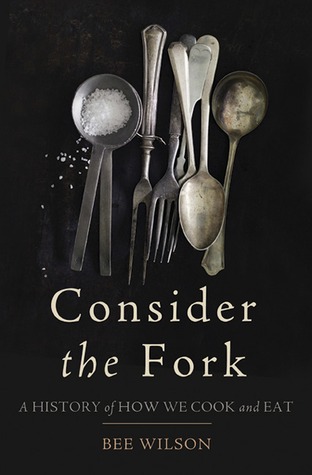I love food. Any type of food, and I love the gadgetry that comes with
the preparation of food. Some new kind of blender? I want to see it. A
trip through the antique store to check out old egg beaters and
mandolines? I'm there. But I never really thought about some of the
basic stuff, which this book explores.
The author takes eight
chapters and breaks down certain kitchen sciences and inventions into
histories. The chapters are as follows: Pots and Pans, Knife, Fire,
Measure, Grind, Eat, Ice & Kitchen. Some of these titles are fairly
simplistic. For instance, Ice encompasses not only Ice Boxes, but Ice
Cream and modern refrigerators as well. And some of the others are
explanatory, like Pots and Pans. Each take you on a history as far back
as the gadget existed and brings it to the modern and the different
types we use now. There are also little sections at the end of each
chapter that explore a single type of gadget, like a nutmeg grater.
Such things as measuring cups, spoons, and even ice cream makers are
discussed. But even down to the explanation of the fork through
history, there's a lot in this book that isn't readily available in
other history books.
Gadgets are interesting. It is possible to
have a kitchen filled with gadgets that only do one thing (like an
avocado cutter) or to just have a few trusty tools like a knife and
stove. Each of these approaches takes a different kind of cook just
like modern vs. traditional cooking takes a different type of cook. And
the author does mention the use of sous-vide and it's rising
popularity. I'm actually intrigued by the concept myself but have no
room for any additional gadgets, especially after my latest foray into a
juicer (and as the simplistic would say, what was wrong with an old
fashioned manual juicer). For this whole book to be about the most
simplistic of cooking utensils though makes it different from a lot of
others. There is no technique being discussed here, just a simple
history of some things we take for granted.
The writing itself
was kind of dry. While I eagerly wanted to learn more about kitchen
history, I had a hard time just sitting down and reading this book in
one sitting and had to break it up a bit. There's a lot of fascinating
information here, but sometimes the minute details are a little too
much, such as the listing on and on of different types of spoons the
Victorians used. I might have been a little more interested if there
was a picture of all these spoons, but when trying to picture them all
in my head, they all looked remarkably like teaspoons to me. And I'm
not trying to say there aren't any pictures in this book. There are a
few illustrations scattered throughout the entire thing. But I feel
that this book could have been made so much better by actual
photographs. Maybe not of everything, but there was a lot in there that
I could try to web search each time, but it would be preferable to have
it right there on the page. It would have broken up the monotony of
all the detail as well. Wilson does tell it with a warm voice, but it's
more like listening to a senior citizen wax on eloquently about how
they walked uphill to school in the snow both ways.
It is an
interesting book if taken in small portions. There's a wealth of
information to be had (and a want for a Marshall Ice Cream machine) and
it did inspire me to visit Ivan Day's website ( a guy who cooks
historically). This is a good read for a foodie or historian.
Consider the Fork
Copyright 2012
279 pages


No comments:
Post a Comment